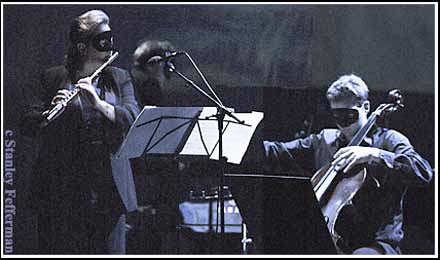| The reality of new music is the renewed reality of music. Josquin, Beethoven, Mendelssohn, and Messaien renewed music with replication of the songs of other creatures. The genius of George Crumb is that he brings us music made of whale songs.
What is it about whale music we want to know? It is music new in the sense of being the replication of a new, never-before-heard ensemble: of whales tuned soprano, alto, baritone and basso, solo and in chorus, playing as if pizzicato, glissando and harmonics, uttering patterns of sound into watery cavernous space, that bring to the dim verge of our ken dimensions of feeling so vast we can only imagine them and exclaim, “O wonder!…O brave new world.”
|
| The renewal of concert programming is why we come to an Andrew Burashko event. Burashko grasped the synergy between Crumb’s “Voice of the Whale”, hunted to the verge of extinction, and “Howl”, the apocalyptic rant of Allen Ginsberg, haunted to paranoia in 1955 by materialistic America, but surviving by his song in the long breathlines he inspired from Isaiah, William Blake and Walt Whitman?
“Howl” is totally relevant to these ears as word-music, various and punchy as a Shostakovich String Quartet, and aligning perfectly the mood of post-Korean-wartime with the current mood of the war in Iraq in this line “Moloch, whose soul is endless oil.” The poem was well integrated into the program and much enhanced by music for piano, bass, and trumpet, commissioned by Burashko from Jonathan Goldsmith who was backed at the keyboard by two outstanding players: George Koller and Michael White. Ted Dykstra’s reading was brave but could not stand as a real variant to the urgent, anxious, authentic voice of Ginsberg so totally committed to the sound of his own truth.
Josh Finlayson on guitar singing and backing Andy Maize extended the tradition of dissent through folksongs of Woody Guthrie and Bob Dylan. These songs let in the light of a simpler musical world where declarations like “Did you have a friend on the good Reuben James?” and “It’s alright Ma, I can take it,” take the short path to the heart.
After the intermission, an electrically amplified Tokai String Quartet presented Crumb’s “Black Angels”, introduced by Burashko as containing some of the ugliest sounds he had ever heard. Again, one had to be astonished by the sonic richness of Crumb’s imagination which yields, as one writer put it, “sounds and textures never before heard.”
In Crumb’s own words, “The amplification of the stringed instruments in ‘Black Angels’ is intended to produce a highly surrealistic effect. This surrealism is heightened by the use of certain unusual string effects, e.g., pedal tones (the intensely obscene sounds of the Devil-Music); bowing on the “wrong” side of the strings (to produce the viol-consort effect); trilling on the strings with thimble-capped fingers. The performers also play maracas, tam-tams and water-tuned crystal goblets, the latter played with the bow for the “glass-harmonica” effect in [the section titled] God-Music.”
The effect of this performance with all its excellencies and accompanied by another Peter Mittler film is to bring us musically into the ruthless action of a sub molecular world. Here tiny entities pop, click, ping, zing, zap, tink into existence, interact at blinding speed in a crowded quantum froth, expire in a flash, are succeeded by nearly identical entities. And so, the cycle–Crumb’s musical metaphor of a wartime way of life.
Crumb’s intention here is not to exchange pleasantries. Mettler’s film joins Crumb in a duet that equates sunlight glinting off ocean waves, sequences of fish schooling, whales podding, bombs falling, napalm exploding, soldiers charging, lying wounded, dying, being buried, wind in bare branches. More sunlight glinting off waves, gulls and pelican diving for prey, all images altering, dissolving, transforming in digital processing, morphing into other forms, endlessly rocking out of the cradle of existenz.
At the end of the performance, there is peace and awe. A good night.
|


